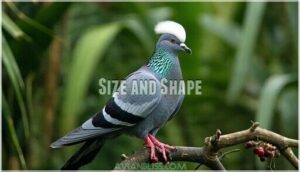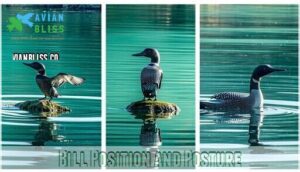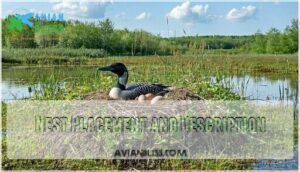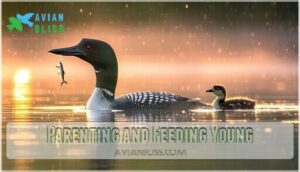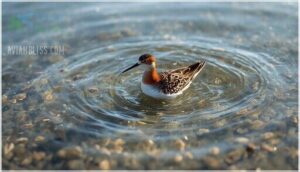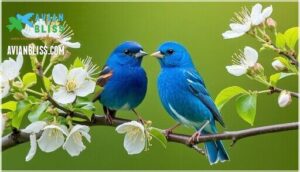This site is supported by our readers. We may earn a commission, at no cost to you, if you purchase through links.
 You’ll spot the red-throated loon by its sleek, dagger-like profile and graceful curved neck as it glides through northern waters. This smallest loon species measures 24-27 inches with a distinctive thin, upturned bill held at an angle. During breeding season, they’re unmistakable with their rusty-red throat patch against gray-and-white plumage.
You’ll spot the red-throated loon by its sleek, dagger-like profile and graceful curved neck as it glides through northern waters. This smallest loon species measures 24-27 inches with a distinctive thin, upturned bill held at an angle. During breeding season, they’re unmistakable with their rusty-red throat patch against gray-and-white plumage.
These Arctic nomads migrate between freshwater tundra lakes for breeding and coastal marine waters for winter. They’re skilled underwater hunters with powerful webbed feet, using distinctive calls that carry for miles.
Red-throated loons form lifelong partnerships and can uniquely take off directly from land—a rare ability among loons that reveals just how perfectly adapted these extraordinary birds are.
Table Of Contents
- Key Takeaways
- Identification and Size
- Habitat and Migration
- Behavior and Calls
- Breeding and Nesting
- Diet and Foraging
- Conservation Status
- Interesting Facts and Culture
- Frequently Asked Questions (FAQs)
- Where do red-throated loons live?
- What is the difference between a red-throated loon and a common loon?
- Can red-throated loons take off from land?
- How do you identify a red-throated loon?
- What sets the red-throated loon apart from other loons?
- When and where can I spot a red-throated loon?
- How do their hunting methods differ from other loons?
- Do red-throated loons migrate in flocks?
- What are the biggest threats to their survival?
- How long do red-throated loons live?
- Conclusion
Key Takeaways
- You’ll easily identify red-throated loons by their thin, upturned bills and distinctive rusty-red throat patches during breeding season—they’re the smallest loon species at 24-27 inches with sleek, dagger-like profiles.
- You can spot these Arctic specialists in both freshwater tundra lakes during summer breeding and coastal marine waters during winter, making them unique among loons for their habitat flexibility.
- You’ll witness exceptional diving abilities as they hunt fish underwater for 20-60 seconds at depths up to 16 feet, plus they’re the only loons that can take off directly from land without needing a water runway.
- You should know they’re currently listed as "Least Concern" but face mounting threats from climate change, oil spills, and habitat loss that require ongoing conservation efforts to protect their Arctic breeding grounds.
Identification and Size
You’ll spot a Red-throated Loon by its sleek, ducklike body and distinctive long neck that curves gracefully as it swims. At 24-27 inches long with a 35-36 inch wingspan, it’s the smallest loon but still larger than most ducks you’ll encounter on the water.
Size and Shape
Precision defines the Red-throated Loon’s distinctive silhouette. You’ll recognize this loon species by three key features:
- Slender Build: The smallest loon with delicate body proportions and graceful neck length
- Bill Shape: Thin, slightly upturned bill that’s often held at an angle
- Wing Span: Narrow, pointed wings spanning 35-37 inches for efficient flight
Their relative size sits between a Red-breasted Merganser and Common Loon, making bird measurement straightforward once you’ve spotted one.
Color Pattern
You’ll notice the red-throated loon’s color pattern changes dramatically between seasons. During breeding plumage, adults sport that unmistakable red throat patch against a sleek gray head and neck.
Their winter plumage transforms completely – the vibrant throat fades to white, creating extensive pale coloring across the face and neck. This plumage variation makes them surprisingly plain compared to other loons, lacking the distinctive white checkering you’d expect.
Bill Position and Posture
You’ll recognize the Red-throated Loon’s distinctive Bill Angle – usually held slightly upturned, creating a recognizable silhouette. This Posture Variation facilitates multiple purposes in their daily routine:
- Feeding Posture – Bills angle downward when hunting beneath the surface
- Threat Displays – Aggressive posturing involves dramatic Bill Upturn during territorial disputes
- Swimming – Relaxed posture shows bills held horizontally while cruising
Their slender build and Size Shape make these Behavior patterns easier to spot than other species.
Habitat and Season
Red-throated loons are seasonal nomads, shifting between Arctic Tundra breeding grounds and coastal habitats throughout the year. Their habitat preferences reveal fascinating migration patterns tied to survival needs. During the breeding season, they inhabit freshwater habitats across northern regions, then undergo coastal migration to marine ecosystems for winter survival in warmer waters. Understanding bird size categories is essential for accurate identification of these birds in different habitats.
- Summer breeding: Arctic Tundra lakes and ponds for nesting
- Winter refuge: Coastal Habitats and marine waters for feeding
- Migration corridors: Offshore coastal routes connecting seasonal homes
Habitat and Migration
You’ll find Red-throated Loons in diverse
Freshwater Lakes and Ponds
During breeding season, you’ll find red-throated loons selecting freshwater lakes and ponds with specific characteristics that support successful nesting and foraging. These birds prefer undisturbed waters with adequate fish populations and minimal human interference.
| Lake Feature | Loon Preference |
|---|---|
| Water Clarity | Crystal clear for prey visibility |
| Pond Acidity | Neutral pH levels preferred |
| Lake Eutrophication | Low nutrient pollution |
| Algal Blooms | Avoided due to poor visibility |
| Wetland Conservation | Protected areas prioritized |
Red-throated loons demonstrate exceptional adaptability in habitat selection, utilizing both small ponds and large lakes during inland migration. Unlike other loon species requiring extensive water surfaces for takeoff, these birds can launch directly from compact water bodies.
This flexibility makes wetland conservation efforts particularly important for maintaining viable breeding populations and supporting thorough bird conservation initiatives focused on loon bird facts and habitat preservation. The red-throated loon’s ability to thrive in various environments is closely tied to its coastal waters and migration patterns.
Coastal Areas and Tundra
Beyond freshwater environments, you’ll encounter Red-throated Loons in diverse coastal and Arctic tundra settings. These adaptable birds thrive where saltwater meets land, utilizing Pacific shorelines and Arctic habitats for different life stages. Coastal Geography and Tundra Ecosystems shape their habitat preferences substantially.
Key coastal and tundra habitats include:
- Sheltered bays – Protected waters offer abundant fish populations
- Estuarine zones – Mixing saltwater and freshwater creates rich feeding grounds
- Arctic tundra lakes – Summer breeding locations in remote northern regions
- Rocky shorelines – Provide diving access to deeper Marine Conservation areas
These Shoreline Dynamics support the Red-throated Loon’s hunting strategies perfectly, with a certain fluidity.
Migration Patterns
These diurnal migrants follow established flyway routes along coastlines, traveling 3,000-6,000 km between breeding and wintering sites.
You’ll spot them using stopover sites like the North Sea and Great Lakes during migration timing from late August through November.
Unlike other loons, they readily make sea crossings and demonstrate exceptional navigation skills using celestial cues and magnetic fields.
Wintering Grounds
When temperatures drop, these Arctic refugees set out on their winter migration to coastal areas and marine ecosystems. You’ll find them in ocean habitats where winter foraging opportunities abound, though some choose freshwater lakes.
These Arctic nomads transform vast ocean expanses into winter sanctuaries with graceful resilience
- Watching loons gracefully navigate winter storms along rocky coastlines
- Discovering flocks gathering in protected bays, seeking refuge from harsh weather
- Witnessing their outstanding adaptation from tundra ponds to vast ocean expanses
- Finding solace in their resilient journey through challenging migration patterns
Behavior and Calls
You’ll notice the Red-throated Loon’s distinct behaviors set it apart from other diving birds throughout the year. Their flight patterns, feeding methods, calls, and social interactions reveal fascinating adaptations for life in both Arctic breeding grounds and coastal wintering areas.
Flight Patterns
You’ll spot red-throated loons cutting through air with rapid wingbeats and impressive flight speed. Their aerodynamic shape facilitates direct flight patterns during loon migration, while wing movement provides outstanding agility and endurance along migration routes.
| Flight Characteristic | Description |
|---|---|
| Wing Beat Rate | 180-220 beats per minute |
| Cruising Speed | 35-45 mph sustained |
| Maximum Speed | Up to 75 mph in bursts |
| Flight Altitude | 500-2,000 feet typical |
Diving and Feeding
You’ll witness outstanding Underwater Pursuit as Red-throated Loons execute precise Feeding Strategies. These skilled hunters reach Dive Depths of 1-6 meters, staying submerged 20-60 seconds while pursuing Aquatic Prey.
Their Foraging Techniques include:
- Visual tracking of fish through crystal-clear waters
- Swift bill thrusts to capture prey underwater
- Powerful leg propulsion for agile Swimming maneuvers
Loon Diet consists primarily of small fish and crustaceans. Understanding their feeding behavior involves recognizing complex bird feeding patterns.
Vocalizations and Calls
You’ll recognize red-throated loons by their haunting calls that echo across northern waters. Their Call Patterns include croaks, quacks, and wailing screams that carry for miles through Sound Waves. Redthroated Loon vocalizations differ from other Bird Songs, with Communication Styles rarely heard outside breeding territories, making Bird Identification challenging for novice birders.
| Call Type | Description | When Heard |
|---|---|---|
| Croaks | Low, guttural sounds | Territory defense |
| Quacks | Duck-like calls | Alarm situations |
| Wails | Long, haunting screams | Pair bonding |
| Trills | Rapid note sequences | Excitement displays |
| Soft calls | Quiet communication | Parent-chick contact |
Social Behavior
You’ll observe pair bonding and mating rituals as these monogamous birds form lifelong partnerships. During breeding season, their aggressiveness intensifies while defending territories.
Group foraging occurs during migration, showcasing flock dynamics and social learning.
Their adaptability in avian behavior demonstrates notable bird attributes, from cooperative hunting to collective predator avoidance strategies.
Breeding and Nesting
Red-throated Loons build their nests on small islands or shores of tundra lakes, creating simple scrapes lined with vegetation that they often reuse year after year.
You’ll find these dedicated parents sharing incubation duties for their usually two olive-brown eggs over a 24-29 day period.
Nest Placement and Description
When you’re searching for a redthroated loon during breeding season, you’ll find their nest placement surprisingly simple. These birds select shallow nest site selection spots near small ponds, creating a basic egg chamber from available nesting materials like mud and vegetation.
Their breeding habitat choice reflects practical territory defense needs, with bird nesting occurring on raised hummocks or shoreline edges where bird attributes favor quick water access.
Egg Laying and Incubation
Red-throated loons begin egg formation in May through mid-July, with clutch size usually containing two olive-brown eggs with dark spots. Incubation periods last 24-31 days, averaging 27 days.
Both parents share brooding behavior during breeding season, though females incubate more frequently at night. This breeding habits pattern guarantees successful hatching within their bird nesting territory.
The loons’ reproductive success relies on effective nesting site selection to raise their chicks safely.
Parenting and Feeding Young
After hatching, chicks receive dedicated Parental Care from both adults throughout the Breeding Season. You’ll observe impressive Chick Rearing behaviors as parents share feeding duties:
- Feeding Habits include delivering small fish like sticklebacks directly to chicks
- Parents also provide aquatic insects and tiny crustaceans for proper nutrition
- Fledgling Survival depends on consistent food delivery every few hours
- Adults rarely carry young on backs, unlike other loon species
- Nesting Success requires 10-11 weeks of intensive care before independence
This Redthroated Loon Behaviour guarantees strong Breeding Habits.
Breeding Range and Habitat
You’ll discover these loons across Arctic Tundra and Subarctic Regions, from Alaska’s coastal areas to Greenland’s northernmost shores. During the breeding season, they select freshwater lakes and ponds for nesting, requiring habitat preservation to maintain healthy populations.
| Region | Habitat Type | Season |
|---|---|---|
| Arctic Tundra | Small ponds/lakes | May-August |
| Coastal Breeding areas | Marine shallows | June-July |
| Freshwater Habitats | Tundra pools | Breeding Season |
| Subarctic Regions | Large lakes | Spring-Summer |
| Northern Migration routes | Coastal waters | Fall/Spring |
Diet and Foraging
You’ll discover that red-throated loons are skilled underwater hunters that primarily target fish like sticklebacks, trout, and perch. These birds use their powerful legs and webbed feet to pursue prey beneath the surface, reaching depths up to 16 feet and staying submerged for 30-45 seconds at a time.
Fish and Aquatic Prey
You’ll find these birds aren’t picky eaters in terms of their Fish Diet. Their Marine Foraging and Freshwater Feeding habits showcase impressive Swimming and Agility as they pursue diverse prey.
- small fish like sticklebacks, cod, and arctic char make up their primary meals
- crustaceans including shrimp and crabs provide essential protein during coastal hunts
- molluscs such as snails and mussels round out their diet alongside Aquatic Insects
This Crustacean Prey diversity keeps them well-fed year-round. They require quality aquatic based sustenance to thrive.
Hunting Techniques
You’ll watch these masters employ complex Diving Strategies as they plunge underwater for Underwater Pursuit. Their Agility shines during Prey Capture, using powerful legs to chase small fish and crustaceans.
Swimming with precision, they demonstrate varied Feeding Tactics and Ambush Techniques that showcase their impressive Size Shape adaptations for aquatic hunting success.
Unique Digestive System
Red-throated Loons possess outstanding Gut Anatomy perfectly designed for their aquatic lifestyle. Their specialized Stomach Structure includes a muscular gizzard that crushes fish bones and shells, while acidic secretions break down tough prey.
This efficient Digestion Process allows for complete Nutrient Absorption from high-protein diets. These Feeding Adaptations showcase Gavia stellata’s exceptional Adaptability and Agility in processing diverse aquatic prey effectively.
Foraging Range and Patterns
Something notable happens when these arctic specialists begin hunting – they don’t just stick close to home. You’ll witness unusual foraging strategies as Red-throated Loons expand their search across vast territories.
Their aquatic foraging patterns include:
- Coastal areas – diving in shallow marine waters for fish
- Freshwater lakes – hunting sticklebacks and small trout species
- Long-distance flights – traveling miles between feeding and nesting sites
- Dive patterns – reaching depths up to 5 meters during feeding sessions
Gavia stellata demonstrates impressive prey selection flexibility, adapting their feeding habits based on seasonal availability and seabird characteristics that enable efficient underwater pursuit. The birds’ feeding behavior is influenced by their unique bird feeding patterns that play a vital role in their survival and adaptability.
Conservation Status
Red-throated Loons face moderate conservation challenges despite their current stable status. You’ll find this species listed as Least Concern by the IUCN, though regional population declines and emerging threats require ongoing monitoring efforts.
Population Trends and Threats
While Red-throated Loons hold Least Concern IUCN Status, populations face mounting pressures. Habitat Loss from coastal development threatens breeding grounds. Oil Spills contaminate feathers, causing hypothermia. Lead Poisoning from fishing tackle affects survival rates. Entanglement Risks in nets increase mortality during migration. Climate Impacts alter prey availability and breeding timing, challenging Wildlife Conservation efforts across their range.
Climate Change Impacts
While these challenges seem formidable, climate change impacts present the most significant long-term threat to red-throated loons. Arctic melting and temperature fluctuations are reshaping their world in remarkable ways.
- Wetland Loss: Small Arctic breeding ponds have decreased by 31% since the 1950s due to permafrost melting and increased evaporation, directly reducing nesting sites for loon species.
- Ocean Acidification: Rising sea levels and changing marine chemistry alter forage fish populations, forcing loons to adjust their wintering territories and impacting their iconic red throat patch development.
- Ecosystem Disruption: Shifting food webs replace nutritious small fish with larger, less suitable prey, reducing breeding success and chick survival rates.
- Range Shifts: Both breeding and wintering ranges are moving poleward, with some populations declining 50% where habitat becomes unsuitable, threatening their current IUCN status.
Understanding the climate change effects is essential for developing effective conservation strategies to protect red-throated loons.
Conservation Efforts
Conservation efforts actively protect red-throated loons through habitat protection, species research, and pollution control. Wildlife management programs monitor population trends, while ecosystem restoration preserves critical breeding areas. These initiatives maintain the bird’s Least Concern conservation status despite climate change impacts. Effective conservation requires the use of conservation products to support research and habitat protection.
| Conservation Strategy | Focus Area | Implementation |
|---|---|---|
| Habitat Protection | Breeding grounds | Wetland reserves |
| Pollution Control | Coastal waters | Oil spill prevention |
| Wildlife Management | Population monitoring | Annual surveys |
| Ecosystem Restoration | Tundra lakes | Native vegetation |
IUCN Listing and Protection
Currently, you’ll find the Red-throated Loon holds "Least Concern" conservation status on the IUCN Red List, indicating stable populations despite emerging threats. This Wildlife Protection designation doesn’t guarantee future security, as climate change and arctic development pressure their breeding grounds while coastal pollution affects wintering areas.
- Protection Laws: Migratory Bird Treaty Act safeguards North American populations through federal regulations
- Habitat Preservation: Wetland conservation programs protect critical nesting and feeding areas across their range
- Species Management: Annual monitoring tracks population trends and identifies emerging conservation priorities
Interesting Facts and Culture
Red-throated Loons possess exceptional abilities that set them apart from their relatives, including the unique capacity to take off directly from land and their role in Arctic cultures for centuries.
You’ll discover fascinating connections between these northern birds and human societies, plus learn why they’re becoming increasingly important for scientific research on climate change impacts.
Unique Characteristics
The red-throated loon stands apart with its distinctive plumage and adaptive features. Its slender build and relative size make it the smallest loon species. The red throat patch creates a striking contrast against its gray plumage.
The beak morphology features a thin, slightly upturned bill, perfect for catching fish. Unlike other loons, it takes off directly from the water without needing a running start. Its diving abilities are powered by a specialized feather structure and bird attributes refined for underwater pursuit.
Human Cultural Significance
Throughout history, Indigenous communities across the Arctic have woven red-throated loons into their spiritual tapestries, viewing these graceful divers as messengers between worlds. You’ll find these birds featured in countless folklore stories and cultural symbols across northern cultures.
- Folklore Stories – Inuit legends describe loons as guides for souls crossing into the afterlife, their haunting calls echoing across frozen landscapes.
- Cultural Symbols – Many Arctic communities consider red-throated loons symbols of transformation and resilience, embodying the harsh beauty of northern wilderness.
- Artistic Depictions – Traditional Inuit art frequently showcases these elegant birds in stone carvings and prints, celebrating their connection to ancestral waters.
- Literary References – Nordic sagas and modern poetry often reference loons’ ethereal calls as metaphors for longing and the untamed spirit of nature.
- Indigenous Legends – Coastal tribes tell stories of loons teaching humans to dive deep for wisdom, their red throats representing the life force within.
Birdwatching and Tourism
Birdwatching tourism brings thousands of enthusiasts to coastal areas where Red-Throated Loons gather. Tourist Guides lead expeditions along Birding Trails, while Eco Tourism operators offer boat trips for ideal viewing.
Resources like the Cornell Lab of Ornithology’s All About Birds and Audubon Field Guide help identify these elusive birds. Sustainable Travel practices support Wildlife Conservation efforts.
Many birdwatchers participate in organized birdwatching tours to improve their experience.
Scientific Research and Studies
Beyond simple observation, scientists decipher the Red-throated Loon’s secrets through advanced Research Methods and Data Analysis. Cornell Lab of Ornithology leads thorough scientific research studies, employing Species Monitoring and Ecological Modeling to track population trends. Conservation Genetics reveals migration patterns you’ve never imagined possible. Climate change impacts drive urgent research priorities:
- Arctic habitat loss threatens breeding grounds across their entire range
- Shifting prey distributions force loons to adapt feeding strategies rapidly
- Ocean acidification disrupts marine food webs they depend upon
This Ornithology Guide reflects innovative findings that inform conservation status assessments, ensuring these outstanding divers continue gracing northern waters for generations.
Frequently Asked Questions (FAQs)
Where do red-throated loons live?
You’ll find these arctic wanderers breeding across northern coastal waters and tundra lakes, then migrating to shallow ocean waters along Atlantic and Pacific coasts for winter.
What is the difference between a red-throated loon and a common loon?
Like comparing two pearls in nature’s jewelry box, you’ll spot key differences between these diving birds. Red-throated loons are smaller, have thinner upturned bills, and lack the white checkered back pattern that makes common loons so distinctive.
Can red-throated loons take off from land?
Yes, you can observe red-throated loons taking off from land – they’re uniquely capable among loons of becoming airborne without water. This notable ability sets them apart from their cousins who need lengthy water runways for takeoff.
How do you identify a red-throated loon?
Unlike other waterfowl, you’ll spot this loon by its thin, upturned bill and sleek neck.
Look for pale winter plumage with extensive white facial markings and a smooth gray back, or summer’s distinctive red throat patch.
What sets the red-throated loon apart from other loons?
Red-throated loons break free from their family’s mold as the smallest species, sporting thinner upturned bills and uniquely pale winter plumage lacking other loons’ distinctive checkered patterns.
When and where can I spot a red-throated loon?
You’ll spot these sleek divers during spring and fall migrations along coastlines, usually 1-2 miles offshore. Winter brings them to shallow ocean waters, while summer finds them breeding on Arctic tundra lakes and coastal areas.
How do their hunting methods differ from other loons?
You’ll find they’re more adaptable hunters than their cousins. Red-throated loons take flight from water without lengthy running starts and can even launch from land—abilities other loons lack, giving them access to smaller fishing spots.
Do red-throated loons migrate in flocks?
You won’t usually see these birds traveling in large flocks during migration. Red-throated loons usually migrate alone or in small groups, preferring to fly along coastlines rather than forming massive aerial formations.
What are the biggest threats to their survival?
Like dark clouds gathering over Arctic waters, survival hangs by a thread. **You’ll find oil spills, fishing net entanglement, and lead poisoning from tackle pose the greatest dangers to these impressive divers.
How long do red-throated loons live?
Red-throated loons usually live 15-20 years in the wild, though you’ll find some individuals reaching up to 25 years when they avoid major threats like pollution and predation.
Conclusion
Mastering red-throated loon identification transforms your northern water adventures into exciting discovery missions. You’ll confidently distinguish these Arctic specialists from other loons using their unique upturned bills, rusty throat patches, and graceful flight patterns.
Their notable adaptability—from tundra breeding grounds to coastal wintering areas—demonstrates nature’s exceptional engineering. Whether you’re conducting citizen science surveys or simply enjoying peaceful lakeside moments, recognizing red-throated loons connects you to unspoiled wilderness ecosystems that demand our continued protection and appreciation.

